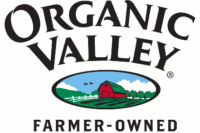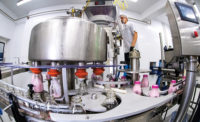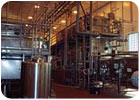
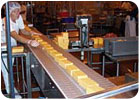
"We still have this one open draining table," says Bil Luth, v.p. of quality, as he gives Dairy Foods a tour of the facility. "We use this for demonstrations, for training purposes and so the cheesemakers can get their hands in the cheese a little bit."
The single open vat is tucked up against a deck platform that holds eight Double O vats that together produce about 160,000 lbs of cheese a day.
"This really isn't a big plant," says Wayne Bean, Tillamook's dir. of cheese operations, who is helping to guide the tour. "It's a manageable size."
The Tillamook facility is certainly not huge by today's standards. As the company grows, its second plant in eastern Oregon is providing the vat space to produce more cheese. But it is a plant of some complexity and quite a bit of character. And while the finite milk supply in Tillamook County means the plant is not adding capacity, it does not keep TCCA from adding automation. Most recently, an additional palletizer was added so that each of the two packaging lines now has a dedicated, automated casing and palletizing unit at the end of the line.
The history of the current plant site goes back to 1947 around the time when four cooperatives (in the early chapters of the Tillamook story, it was an association of cooperatives) consolidated to build a centralized plant. A more modern facility was built on the site in 1969 after seven other cooperatives merged to form the basis of the current organization. Along the way there have been additions and expansions, including the installation of the enclosed Double O vats in 1991 and an expansion in 2000 that included the construction of one of the industry's most sophisticated Automated Storage and Retrieval Systems (AS-RS).
The plant also includes three ice cream lines that produce more than 8,000 gals of ice cream a day. And a visitors center, which entertains as many as 4,000 visitors a day during the peak summer season is one of Oregon's top tourism destinations.
The Tillamook County facility is a great destination for those interested in cheese, and when combined with a nearly identical satellite plant, it helped Tillamook County Creamery Assn. achieve a record $309 million in sales in 2004.
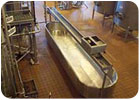
Fresh milk and careful handling
Currently the plant receives 40 to 45 truck loads of milk totaling about 1.7 million lbs of milk per day, all of it from member farms in and around Tillamook County. This ultimately equates to a daily production of 70 tons of cheese, and 85,000 lbs of powdered whey.Milk is received through one of two drive-through receiving bays. Samples are taken and tested and the milk is sent for a short period to one of six storage silos, with a total capacity of about 165,000 gals. When a production run is started, the milk is pumped to the make room which was upgraded in 1990 with the installation of an APV HT/ST system that can process up to 100,000 lbs of milk an hour.
"Because all of our cheese is aged, we don't use standard pasteurization," Luth explains. "We use what we call a heat shock which is about 151 degrees for about 30 seconds. That's a bit gentler on the milk and produces a better quality milk for the cheesemaking."
The milk is standardized to the correct fat ratio and a vacuum is applied to remove odors. It is then pumped to the starter room where an inline system adds starter, it then goes to the cheesemaking room to fill one of the vats, each of which holds about 6,000 gals.
"The cheesemaking isn't totally computerized," says Plant Mgr. Rich Snyder. "The cheesemakers add rennet and color by hand. We think it's important to do some of the work by hand."
It takes about 40 minutes to fill a vat and the total set time is about 30 minutes. The temperature is raised gradually to about 100° F. Once the curd bed has formed it is cut into 1/4-inch pieces and whey separation begins. When the curd and whey mixture is ready it is transferred to the Cheddaring equipment. Tillamook's unit, manufactured in New Zealand by Pro Tap-APV was installed in 1991 in a major automation upgrade that included the Double O vats.
The cheese travels slowly along the belts inside the cheddaring equipment, while the remaining whey is drained and a mat forms. That mat is gently turned until the proper acidity and body develop, then the matted curd is milled into small pieces which are then deposited on a salting belt. The finished curds are transferred by vacuum to the top of one of eight 20 ft high block towers, which form and cut the cheese into 40 lb blocks.
The blocks are sealed with a Cryovac system, then boxed in corrugated paperboard, and sent to a block chiller which brings the core down to palletizing temperature in less than 24 hours.
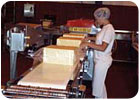
High rise of cheese
Once the cheese is ready for storage it enters the realm of one of the most remarkable features of Tillamook's plant-a high rise of cheese that represents one of the most automated storage systems in the industry.In 1998 TCCA found that it was storing more than 10 million lbs of its cheese at outside facilities. It made more sense to build a system that would allow Tillamook to age its cheese on site. For that, Tillamook worked with Westfalia Technologies Inc., York, Pa., to create a 12-level, 90-ft. high Automated AS-RS with more than 15,000 pallet positions. It features an unmanned, computer-controlled crane equipped with Westfalia's unique Satellite Pallet Transport Shuttle to move individual pallets out of the lanes. Using a unique counter-rotational chain conveyor the shuttle drives in and out beneath the pallet while lifting or lowering it.
The operation of the automated warehouse is controlled by Westfalia's Warehouse Management System (WMS) on a Wonderware platform. Instructions are sent to personnel or machines by issuing "missions" that describe the movement of material from one location to another.
The AS-RS operates around the clock, repositioning pallets in anticipation of the next day's activities long after staff has gone home for the day.
"We have 100% control of our inventory thanks to this system. Our inventory control is as near perfect as you can get," says Snyder. "It's really amazing how well it has worked."
The warehouse is divided into two sections, one for blocks and one for packaged cheese. A single crane serves both sections, but climate is controlled at different levels for each. The warehouse stores a total of 35 million lbs of cheese.
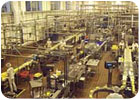
Grading and packaging
Tillamook packages stirred curd cheeses at about 30 days of age, medium cheddar is over sixty days old, and much of the cheese is aged nine months to two years.A staff of four cheese graders in the quality assurance department uses sensory evaluations to determine the grade and how much aging the cheese will receive. Initially, all blocks are treated equally in the AS-RS, with the exception of white cheddar which is destined to be aged two years and sold as Vintage White products. Once cheese is graded, new barcode scanner information is placed on pallets. That information is then read by the AS-RS for tracking.
When the cheese has been aged it is sent to a knockout area where the blocks are removed from the corrugated paperboard and the plastic liner in preparation for cutting and wrapping.
"We have three packaging lines in operation here," says Snyder as the tour continues. "Our biggest seller is the 2-lb loaf, so we run a lot of it. In a normal day we will package as much as 250,000 lbs of cheese total."
Blocks are fed into one of several machines that cut them down to loaf size. Operators monitor the resulting loaves and using a checkweigher, add or subtract cheese as needed to specifications for the correct weight.
A combination of Cryovac "octopus" machines and horizontal form-fill-seal machines are used to wrap the cut pieces some of which then travel through a heat tunnel to shrink the film.
Labels are applied where needed and the pieces are then conveyed to the secondary packaging area where they are put into cartons. Just this fall, Tillamook installed a second case former and automatic palletizer in this area.
Finished cheese goes back into the AS-RS until it is picked for an order. Shipments are sent out through one of seven load out bays.
The plant also has state-of-the-art labs for milk quality testing and product evaluation. A brand new computerized microbial analysis scanner recently installed in the milk quality lab is the first of its kind in the western U.S. Luth says the improvements in lab equipment allow Tillamook to conduct an ever increasing number and depth of tests, and to retrieve and share the information more quickly than ever.
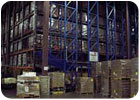
Frozen desserts
Tillamook's ice cream business is focused primarily in the Pacific Northwest. It has grown substantially in the last 30 years, and so its operations have had to keep pace."We made about three million gallons of ice cream this year," says Ice Cream Mgr. Hank Thun. "In 1985 we made 86,000 gallons."
The ice cream lines utilize three Tetra Pak Hoyer freezers that together, can run 850 gals an hour.
A carton former uses printed paper stock from Huhtamaki to form 56 oz convocan rounds, for retail. Three-gal tubs are filled for food service, much of it to be sold by the scoop at Tillamook's visitors center, but other scoop shop customers are served including some area McDonald's.
For the retail packages a tamper evidence band is applied and heat shrunk prior to hardening. A Northfield spiral hardener provides an environment of about minus-20°F, and the packages reside in it for about two hours.
After hardening the packages are poly packed in pairs and sent to warehouse storage. Most storage is done through an independent distribution center in Portland.

Sidebar: Tillamook's Satellite Plant Undergoing Expansion
BOARDMAN, Ore.-When Tillamook Cheese established the Columbia River Processing facility here in 2001 it was designed to mirror the cooperative's headquarters plant in Tillamook. Now the new plant is undergoing an expansion that will in effect give Tillamook three times the production capacity it had before 2001.The co-op broke ground earlier this year on the $50 million project and it is hoped that it will be completed by late 2006. The project will include the addition of eight new Double O vats and a second HTST, an additional Cheddaring machine and salter, more block formers and chillers, and additional whey processing equipment. Other plant infrastructure was designed to anticipate expansion.
"Our market is continuing to grow and so are our customers in the retail grocery business," said Jim McMullen, pres. and CEO of Tillamook. "Our customers expect us to grow with them in order to meet their needs. Expanding TCCA's cheese making capabilities ensures that we can keep up with our customers' growing needs. It will also secure the future of the Tillamook brand."
Tillamook branded products made at Columbia River Processing include: Medium Cheddar, Monterey Jack, Pepper Jack, Colby, Colby Jack and Mozzarella. Concentrated whey and whey cream are also produced. The Boardman facility can receive 1.6 million lbs, (about 181,000 gals) of milk per day and produce 65 million lbs of cheese, and 160 million lbs of concentrated whey per year.
Production in the expanded portion of the plant is scheduled to begin in 2007. Once operating, TCCA's cheese production per year is expected to grow to 190 million lbs.

Sidebar: Visitors Keep Coming Back to Tillamook
The natural beauty of Oregon's coast provides an ideal environment for one of the most successful dairy visitors centers in the U.S. at Tillamook Cheese.Tourists from Oregon, Washington, and California make up the bulk of the plant's visitors each year, but others have come from around the world. Nearly a million people visit the center each year, with about half of them making the trip during the three summer months. And what keeps them coming back?
"The ice cream is certainly a big draw," says Susan Palmer, Tillamook's dir. of retail operations. "I think too that people appreciate that there is no admission charge. They can bring the family and have a really good time without spending a lot of money."
About forty flavors of ice cream are available at any given time, including regionally- inspired flavors like Marionberry Pie. The ice cream sold at the visitors center has really been the driver behind Tillamook expanding its ice cream business throughout the Northwest. There is a main parlor on the ground floor and a second upstairs that is used during the peak summer season.
If guests arrive hungry enough that they want a meal before sampling ice cream there are full breakfast and lunch menus in the Tillamook Café.
Of course the focal point of the visitors center is the tour of the cheese plant. An enclosed second-floor gives visitors a bird's eye view of the cheesemaking operations on one side and the packaging room on the other.
This area includes several informational kiosks and displays detailing the cheese making process and the history of cheesemaking, including some brand new interactive features.
There is also a retail store featuring cheese, butter, ice cream and other Tillamook branded products that offers free samples of cheese.
Sidebar: Tillamook Suppliers
EquipmentAPV/NDA
AGC Engineering
Cryovac
Feldmeier
Fristam Pumps
GEA Westfalia
Separator
Hi-Speed Checkweigher
Hayssen
Realcold Milmech
Schneider Packaging
Equipment
Stoelting
Tetra Pak Hoyer
Wincanton Engineering
AS-RS
Westfalia Technologies
Lab Equipment
Bentley
Foss Bactoscan®
Packaging
Cryovac
Curwood
Huhtamaki
